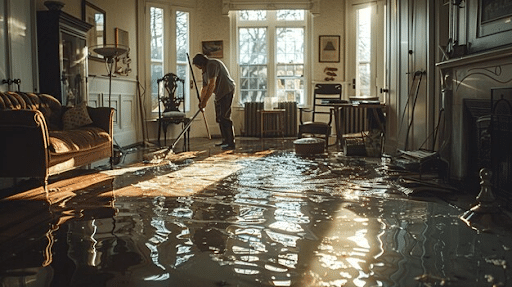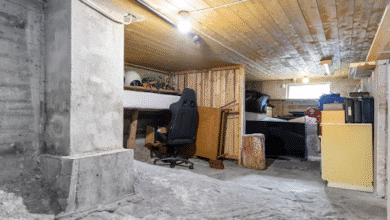A Comprehensive Guide to Water Damage Restoration

Water damage is one of the most common and costly problems homeowners face. Whether caused by floods, plumbing leaks, or burst pipes, water damage can weaken structures, promote mold growth, and lead to extensive property loss. This guide provides a detailed overview of the water damage restoration process, helping you address the issue effectively.
Understanding the Effects of Water Damage
Water damage can affect your home in several ways, compromising its structural integrity and creating environmental hazards. Understanding these effects is essential for timely intervention.
Structural Damage
Excess water weakens building materials like wood, drywall, and concrete, leading to warping, buckling, and even structural collapse if left untreated.
Mold Growth
Moisture provides the perfect environment for mold to thrive. Mold can grow within 24-48 hours of water exposure, causing health risks such as allergies, asthma, and infections.
Electrical Hazards
Floodwater can damage electrical systems, posing risks of shocks and fires. Always ensure electricity is turned off before entering water-damaged areas.
Property Loss
Furniture, personal belongings, and appliances can suffer irreversible damage if not dried and cleaned promptly.
The Water Damage Restoration Process
The water damage restoration process involves multiple steps to remove water, clean affected areas, and restore your home to its pre-damage condition.
Step 1: Inspection and Assessment
A water damage restoration specialist assesses the extent of the damage using moisture detectors and thermal cameras. This helps determine the severity of water exposure and identify hidden moisture pockets.
Step 2: Water Removal
Specializing using equipment like pumps and industrial vacuums to extract standing water. Removing water quickly is critical to prevent further damage and reduce drying time.
Step 3: Drying and Dehumidification
After water removal, high-powered air movers and dehumidifiers dry out the affected areas. This step ensures that no moisture is left behind, preventing mold growth and structural deterioration.
Step 4: Cleaning and Sanitizing
Surfaces, furniture, and personal belongings are cleaned and disinfected to remove contaminants. Anti-microbial treatments are often used to eliminate mold spores and bacteria.
Step 5: Restoration and Repairs
This final step involves repairing or replacing damaged materials such as drywall, flooring, or insulation. Restoration ensures the property is safe, functional, and aesthetically restored.
DIY vs. Professional Water Damage Restoration
Deciding whether to handle water damage yourself or hire professionals depends on the severity of the situation and your capabilities.
When DIY Is an Option
Minor leaks or small areas of water damage can often be managed with household tools, fans, and cleaning supplies. Ensure you wear protective gear and follow safety precautions.
When to Call Professionals
Extensive damage, contaminated water (like sewage), or mold growth requires professional expertise. Certified restoration specialists have the equipment and training to handle large-scale damage effectively.
Preventing Water Damage
Taking proactive steps can reduce the likelihood of water damage and minimize its impact if it occurs.
Regular Maintenance
Inspect and maintain your home’s plumbing system, roof, and gutters to prevent leaks and water intrusion. Address minor issues like dripping faucets or cracked pipes promptly.
Install Preventative Systems
Use sump pumps, backflow valves, and water alarms to detect and control water entry. Installing proper drainage systems can also help direct water away from your home.
Respond Quickly to Leaks
Even small leaks can escalate into major problems if ignored. Repair leaks immediately to avoid long-term structural damage and mold growth.
Health and Safety Concerns
Water damage restoration often involves exposure to health hazards, especially in cases of sewage backups or floodwater. Taking proper precautions is essential.
Dealing with Contaminated Water
Floodwater and sewage may contain harmful pathogens, chemicals, and debris. Always avoid direct contact and wear protective clothing when handling these situations.
Mold and Air Quality
Mold spores released into the air can cause respiratory issues and allergies. Proper drying and cleaning are critical to improving indoor air quality and preventing health problems.
Electrical Risks
Standing water around electrical systems can cause shocks or fires. Always consult a professional electrician to inspect your home after water damage.
The Role of Insurance in Water Damage Restoration
Homeowners’ insurance often covers water damage, but understanding your policy is key to filing a successful claim.
Covered vs. Uncovered Damage
Most policies cover sudden and accidental water damage, such as from burst pipes. However, gradual damage from neglect or maintenance issues may not be covered.
Documenting the Damage
Take photos and videos of the affected areas before starting restoration. Keep receipts and records of repair costs to submit with your insurance claim.
Working with Restoration Companies
Many restoration companies work directly with insurance providers, streamlining the claims process and ensuring you receive adequate compensation.
Emotional and Financial Recovery
Water damage can be both emotionally and financially overwhelming. Taking steps to address these challenges can help you recover more smoothly.
Coping with Loss
Losing sentimental items can be distressing. Focus on salvaging what you can and seek support from family or professional counselors if needed.
Managing Costs
Budgeting for repairs and restoration can be challenging. Look into financial aid programs or discuss payment plans with your restoration company to ease the burden.
Rebuilding Confidence
Restoring your home to its pre-damage state is a significant step toward emotional recovery. Take the time to ensure repairs are done thoroughly and professionally.
Conclusion
Water damage restoration is a multi-step process that requires prompt action, careful planning, and professional expertise. By understanding the restoration process, taking preventative measures, and working with trusted professionals, you can protect your home and ensure a full recovery. Acting quickly is the key to minimizing damage and safeguarding your property for the future.






